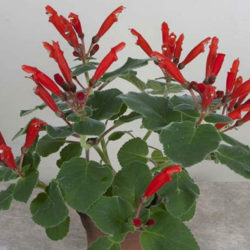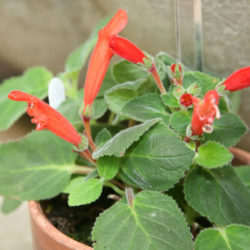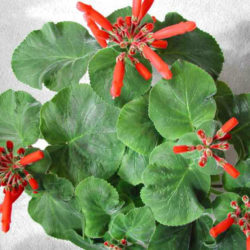Scientific Name
Sinningia cardinalis (Lehm.) H.E.Moore
Common Name(s)
Cardinal Flower
Synonym(s)
Corytholoma cardinale, Dircaea cardinalis, Gesneria cardinalis, Rechsteineria cardinalis
Scientific Classification
Family: Gesneriaceae
Genus: Sinningia
Description
Sinningia cardinalis is a beautiful plant with annual, erect to ascending stems bearing velvety, bright-green leaves that sprout in the spring from a round basal caudex. The stems are pale green, hairy, and can grow up to 12 inches (30 cm) long. The tuber can reach 2.4 inches (6 cm) in diameter. The leaves are ovate to heart-shaped, up to 8 inches (20 cm) long, and 6 inches (15 cm) wide.
Flowers are brilliant orange-red, hooded, up to 2 inches (5 cm) long, and can appear multiple times from late winter to mid-summer.
Origin
Sinningia cardinalis is native to Brazil (Rio de Janeiro).

Hardiness
USDA hardiness zones 11a to 11b: from 40 °F (+4.4 °C) to 45 °F (+7.2 °C).
How to Grow and Care
Sinningias grow from tubers, so there is seasonality to them. When the plant is actively growing, keep it lightly moist. When the foliage dies back, mist the soil regularly to keep the tubers from drying out too much. Start your regular watering when new leaves start to show. As with most plants, Sinningias can survive a short drought, but they do not recover from drowning. Use tepid water when watering. Nobody enjoys a cold shower. Water the soil, not the plant. Sinningias are prone to crown rot and gray mold, which happens when the leaves stay wet. Do not let the plant sit in water, and it must be well-drained.
These are shade plants. Morning or soft late afternoon light is best. That means an East, shaded West, or North-facing window. By all means, avoid direct sun during the harsh "skin cancer" hours of the day.
Learn more at How to Grow and Care for Sinningia.
Links
- Back to genus Sinningia
- Succupedia: Browse succulents by Scientific Name, Common Name, Genus, Family, USDA Hardiness Zone, Origin, or cacti by Genus
Photo Gallery
Click on a photo to see a larger version.


